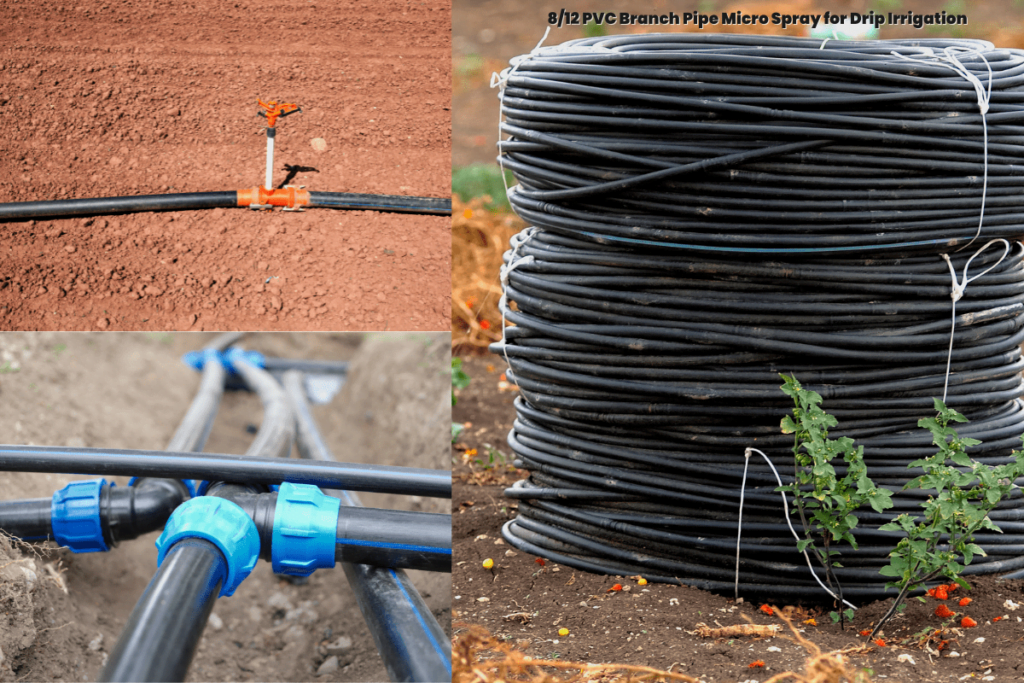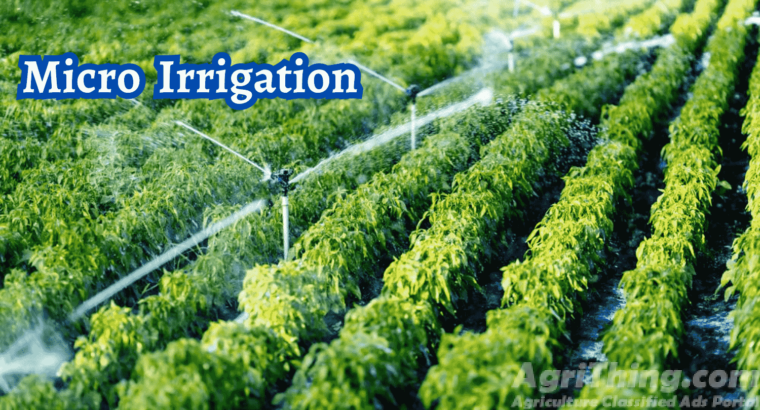Unlocking the Power of Micro Irrigation: Maximizing Efficiency and Growth
Properly watering plants is vital for maintaining their health and ensuring efficient water usage in gardening and farming. Micro irrigation is a popular way to water plants because it’s efficient and accurate. In this article, we’ll discuss how to improve your watering schedule with Micro irrigation. We’ll examine why it’s good and what can affect the schedule. We’ll also give you a simple guide to help you how to water your plants in the best way.
Table of Contents
Understanding Drip Irrigation
Drip irrigation provides water to plants by sending water straight to their roots through tubes or emitters. Unlike sprinkler systems that spread water all over, Micro irrigation delivers water exactly where needed. This method helps prevent water from evaporating, lowers the growth of weeds, and keeps the soil moisture just right.
Benefits of Trickle Irrigation
Drip irrigation has many advantages compared to traditional watering methods:
- Saves Water: Micro irrigation delivers water straight to the roots, reducing waste from evaporation and runoff.
- Fewer Weeds: By providing water only to the plant’s roots, trickle irrigation limits moisture for weeds, keeping their growth in check.
- Healthier Plants: Precise water delivery ensures plants get the right amount of hydration. This leads to better growth and more productivity.
- Lower Risk of Disease: Micro irrigation avoids watering the leaves. Thus, reducing the chances of plant diseases caused by wet foliage.
- Time and Effort Saving: Drop-by-drop irrigation systems need less maintenance and manual work once correctly set up than traditional watering methods.


Factors Affecting the Watering Schedule
To make your watering schedule beneficial with Drip irrigation, you need to think about these factors:
- Type of Plant and Stage of Growth: Different plants need different amounts of water depending on their species, how old they are, and the environment they’re in.
- Type and Composition of Soil: The kind of soil you have affects how well it holds water and how quickly it drains.
- Climate and Weather: How hot or cold it is, how much it rains, and how humid it is. All affect how often and how much water your plants need.
- Sunlight: Plants that get a lot of sunlight might need watering more often because the water can evaporate faster.
- Size and Material of Containers: Growing plants in pots or containers might need watering more often than in the ground because the soil volume is smaller, and the water dries up quickly.
Importance of Watering Schedule Optimization
Optimizing your watering schedule with drip irrigation is really important for these reasons:
- Saving Water: Micro irrigation delivers the right amount of water directly to the roots, so less water is wasted. It helps protect our valuable water resources.
- Healthy Plants and Growth: When you have a well-optimized watering schedule, your plants get the right amount of water they need. This helps them grow well and be more productive.
- Saving Money: Trickle irrigation reduces water usage and the risk of overwatering. This can lead to notable savings on your water bills.
- Saving Time: When you optimize your watering schedule, you don’t have to guess how much water your plants need. You can automate the process and save time by not having to water manually.
- Being Environmentally Friendly: Micro irrigation is a sustainable way to garden. It helps reduce water usage and prevents runoff, which is better for the environment.
Tips for Efficient Watering with Drip Irrigation
To make your drop-by-drop irrigation system as efficient as possible, follow these tips:
- Mulch the Soil: Spread organic mulch around your plants. This helps reduce water evaporation, keep the soil moist, and prevent weed growth.
- Group Plants with Similar Water Needs: Arrange your plants in clusters based on their water requirements. This prevents overwatering or underwatering specific areas.
- Check and Clean Emitters: Regularly inspect the emitters in your drip irrigation system. Remove any clogs or blockages to ensure proper water flow.
- Consider Using a Smart Controller: Upgrade your system with an intelligent controller that adjusts watering schedules based on real-time weather data and soil moisture levels.
- Maintain the System: Perform regular maintenance tasks like checking for leaks, adjusting the system as plants grow, and replacing worn-out parts.


Common Mistakes to Avoid
When optimizing your watering schedule with drip irrigation, avoid these common mistakes:
- Overwatering: Giving plants too much water can cause root rot, nutrient loss, and unnecessary water usage.
- Underwatering: Insufficient water can stress plants, slow their growth, and reduce productivity.
- Poor System Design: Improperly designed micro irrigation systems may distribute uneven water.
- Failure to Adjust the Schedule: Remember to adjust the watering schedule according to plant needs, weather conditions, and seasonal changes can lead to awful growth and water wastage.
- Neglecting Maintenance: Ignoring regular care tasks can result in clogged emitters, leaks, or system malfunctions, compromising efficiency.
Watering Schedule Optimization with Drip Irrigation for different Plants
| Plant Type | Soil Type | Sunlight Exposure | Watering Schedule |
|---|---|---|---|
| Tomatoes | Sandy loam | Full sunlight | Every 2 days for 30 minutes |
| Roses | Clay | Partial shade | Every 3 days for 20 minutes |
| Lettuce | Loamy | Full sunlight | Every 1 day for 15 minutes |
| Succulents | Sandy | Full sunlight | Every 5 days for 10 minutes |
| Citrus Trees | Well-drained | Full sunlight | Every 4 days for 40 minutes |
Conclusion
Watering Schedule Optimization with Micro Irrigation is essential for gardeners and farmers. By considering factors that affect watering needs, setting up an efficient Micro irrigation system, and regularly monitoring and adjusting the schedule, you can save water, keep your plants healthy, and have a successful harvest. Embrace the benefits of drip irrigation and take proactive steps towards sustainable and effective watering practices in your garden.
Get your 8/12 PVC Branch Pipe Micro Spray for Drip Irrigation, Garden Irrigation, and more at Agricomplex. Don’t wait, shop now!

Frequently Asked Questions (FAQ’s)
How does Micro irrigation help save water?
Micro irrigation delivers water directly to the plant’s roots. Thus, minimizes water loss from evaporation and runoff. This targeted system reduces water waste and helps conserve our water resources.
Can I use trickle irrigation for all types of plants?
Yes, trickle irrigation can be used for various plants, such as vegetables, flowers, shrubs, and trees. However, it’s essential to consider the specific water needs of each plant and adjust the system accordingly.
What are the benefits of using an intelligent controller with drip irrigation?
An intelligent controller uses weather data and soil moisture measurements to adjust the watering schedule automatically. This optimizes water usage, reduces the risk of overwatering, and ensures plants receive the right amount of water based on real-time conditions.
How often should I adjust my watering schedule?
Regularly monitor soil moisture levels, plant health, and weather conditions to determine if adjustments are needed. Changes may be required due to seasonal variations, plant growth stages, or shifts in weather patterns.
Are there any other maintenance tasks for drip irrigation systems?
Yes, drip irrigation systems require regular maintenance. Tasks include checking for leaks, cleaning emitters, adjusting the system as plants grow, and replacing worn-out parts. Regular maintenance ensures the system works efficiently and effectively.
Related Articles
looking to purchase a Drip irrigation accessories? Visit our Agricomplex website. Easy and helpful information just for you!
People Also Asked
How does micro irrigation work?
Micro irrigation delivers water right to plant roots using tubes or emitters, ensuring efficient and even water distribution.
What are the benefits of drip irrigation?
Drip irrigation saves water by reducing evaporation and runoff, stops weeds from growing, helps plants stay healthy, lowers the risk of disease, and needs less maintenance time and effort.
What factors affect the watering schedule with drip irrigation?
The watering schedule in micro irrigation depends on the plant type and growth stage, soil type and composition, climate and weather conditions, amount of sunlight, and the size and material of containers.
Why is it essential to optimize the watering schedule with drop-by-drop irrigation?
Optimizing the watering schedule in drop-by-drop irrigation saves water, helps plants grow well, saves money, saves time, and supports environmentally friendly gardening.
How can an intelligent controller improve drip irrigation?
An intelligent controller can adjust watering schedules using weather data and soil moisture levels. This ensures that water is used wisely and plants stay hydrated.




